Study on Stone Blocks Used for Resthouses Along the Northwest Royal Road Connecting Angkor in Cambodia and Phimai in Thailand Based on On-Site Magnetic Susceptibility Measurements and Chemical Composition Analyses
Abstract
1. Introduction
2. Methods
3. Results
3.1. Description of Each “Resthouse”
3.1.1. Pr. Sampov
3.1.2. Pr. Saman Teng
3.1.3. Pr. Kok Ac Chring
3.1.4. Pr. Kok Mon
3.1.5. Pr. Ta Kill
3.1.6. Pr. Ampil
3.1.7. Pr. Kok Phnov
3.1.8. Pr. Ta Muan
3.1.9. Pr. Thamo
3.1.10. Pr. Ban Bu
3.1.11. Pr. Non Kong
3.1.12. Pr. Nong Phlong
3.1.13. Pr. Non Ta Plaeng
3.1.14. Pr. Samrong
3.1.15. Pr. Huai Kaen
3.1.16. Pr. Ku Sila Khan
3.2. Size of Laterite and Sandstone Blocks
3.3. Results of Magnetic Susceptibility Measurements and Chemical Composition Analyses
3.3.1. Laterite
3.3.2. Sandstone
3.4. Results of Chemical Composition Measurements
3.4.1. Laterite
3.4.2. Sandstone
4. Discussion
5. Conclusions
- Laterite was the primary building material of the “Resthouses” along the Northwest Royal Road, except for Pr. Ku Sila Khan in Thailand. At Pr. Ku Sila Khan, the northernmost “Resthouse”, fine-grained red sandstone served the main building material.
- As the primary building material, laterite was used for the “Resthouses” along the Northwest Royal Road, whereas valuable sandstone was used for those along the East Royal Road. This suggests that the Northwest Royal Road was of lesser importance compared to the East Royal Road.
- The laterite is inferred to have been sourced from at least ten different quarries, based on its magnetic susceptibility and V, Sr, and As contents.
- The fine-grained red sandstone and white siliceous sandstone used for the door and window frames of the northern “Resthouses” in Thailand may have been sourced from the Khok Kruat Formation and the Phu Phan Formation, respectively.
- The white siliceous sandstone, red siliceous sandstone, and gray sandstone used for the frame materials of the openings in Cambodia are deduced to have been sourced from the Phra Wihan Formation, the Sao Khua Formation, and the Phu Kradung Formation, respectively.
- The sandstone used in the door and window frames of the “Resthouses” appears to have been determined by the surrounding geology.
Supplementary Materials
Author Contributions
Funding
Data Availability Statement
Acknowledgments
Conflicts of Interest
References
- Uchida, E.; Shimoda, I.; Shimoda, M. Consideration of the construction period of the Khmer temples along the east royal road to Preah Khan of Kompong Svay and the provenance of sandstone blocks based on their magnetic susceptibility. Archaeol. Discov. 2013, 1, 37–48. [Google Scholar] [CrossRef]
- Lunet de Lajonquière, E. Inventaire Descriptif des Monuments du Cambodge; E. Leroux: Paris, France, 1911; Volume 3. [Google Scholar]
- Foucher, A. Nouvelles et Mélanges. Critique de E. Lunet de Lajonquière, 1902, Inventaire descriptif des monuments du Cambodge. J. Asiat. 1903, 10, 174–180. [Google Scholar]
- Finot, L. Dharmaçalas au Cambodge. Bull. Éc. Fr. Extrême-Orient 1925, 25, 417–422. [Google Scholar] [CrossRef]
- Coedés, G. La stele du Práh Khan d’Angkor. Bull. Éc. Fr. Extrême-Orient 1941, 41, 255–302. [Google Scholar]
- Welch, D.J. Archaeological evidence of Khmer state political and economic organization. Bull. Indo-Pac. Prehistory Assoc. 1997, 16, 69–78. [Google Scholar]
- Jacques, C.; Lafond, P. L’Empire Khmer, Cités et Sanctuaires Vème-XIIIème Siècle; Fayard: Paris, France, 2004. [Google Scholar]
- Hendrickson, M. Arteries of Empire—An Operational Study of Transport and Communication in Angkorian Southeast Asia. Ph.D. Thesis, University of Sydney, Sydney, Australia, 2007. Unpublished. [Google Scholar]
- Hendrickson, M. People around the houses with fire: Archaeological investigation of settlement around the Jayavarman VII “resthouse” temples. Udaya J. Khmer Stud. 2008, 9, 63–79. [Google Scholar]
- Lertlum, S.; Shibayama, M. Application of Geo-Informatics to the Study of the Royal Road from Angkor to Phimai. Southeast Asian Stud. 2009, 46, 547–563. [Google Scholar]
- Williams-Thorpe, O.; Thorpe, R.S. Magnetic susceptibility used in non-destructive provenancing of Roman granite columns. Archaeometry 1993, 35, 185–195. [Google Scholar] [CrossRef]
- Williams-Thorpe, O.; Jones, M.C.; Tindle, A.G.; Thorpe, R.S. Magnetic susceptibility variations at Mons Claudianus and in Roman columns: A method of provenancing to within a single quarry. Archaeometry 1996, 38, 15–41. [Google Scholar] [CrossRef]
- Williams-Thorpe, O.; Jones, M.C.; Webb, P.C.; Rigby, I.J. Magnetic susceptibility thickness corrections for small artefacts and comments on the effects of background materials. Archaeometry 2000, 42, 101–108. [Google Scholar] [CrossRef]
- Alva-Valdivia, L.M.; Agarwal, A.; Cruz-Y-Cruz, T. Magnetic susceptibility. In Encyclopedia of Archaeological Sciences; Lόpez Varela, S.L., Ed.; Wiley: Hoboken, NJ, USA, 2018; pp. 1–4. [Google Scholar]
- Tanikawa, W.; Tokuyama, H.; Mochizuki, Y.; Yamamoto, Y.; Hamada, Y.; Takagi, S.; Watanabe, J. Provenance of granitic gravestones in graveyard of feudal lords evaluated by multiple non-destructive rock analyses. J. Cult. Herit. 2022, 56, 183–192. [Google Scholar] [CrossRef]
- Imai, N.; Terashima, S.; Itoh, S.; Ando, A. 1994 compilation values for GSJ reference samples, “Igneous rock series”. Geochem. J. 1995, 29, 91–95. [Google Scholar] [CrossRef]
- Potts, P.J.; West, M. Portable X-Ray Fluorescence Spectrometry. Capabilities for In-Situ Analysis; RSC Publishing: Cambridge, UK, 2008. [Google Scholar]
- Mendoza Cuevas, A.; Bernardini, F.; Gianoncelli, A.; Tuniz, C. Energy dispersive X-ray diffraction and fluorescence portable system for cultural heritage applications. X-ray Spectrom. 2015, 44, 105–115. [Google Scholar] [CrossRef]
- Tykot, R.H. Using nondestructive portable X-ray fluorescence spectrometers on stone, ceramics, metals, and other materials in museums: Advantages and limitations. Appl. Spectrosc. 2016, 70, 42–56. [Google Scholar] [CrossRef] [PubMed]
- Geological Survey of Vietnam. Geological Map of Cambodia, Laos, and Vietnam (at 1:1,000,000 Scale), 2nd ed.; Geological Survey of Vietnam: Hanoi, Vietnam, 1991. [Google Scholar]
- Department of Mineral Resources of Thailand. Geological Map of Thailand (at 1:1,000,000 Scale); Department of Mineral Resources of Thailand: Bangkok, Thailand, 1999. [Google Scholar]
- Uchida, E.; Watanabe, R.; Osawa, S. Precipitation of manganese oxides on the surface of construction materials in the Khmer temples, Cambodia. Herit. Sci. 2016, 4, 1–17. [Google Scholar] [CrossRef]
- Uchida, E.; Maeda, N.; Nakagawa, T. The laterites of the Angkor monuments, Cambodia. The grouping of the monuments on the basis of the laterites. J. Min. Pet. Econ. Geol. 1999, 94, 163–175. [Google Scholar] [CrossRef]
- Uchida, E.; Watanabe, R.; Cheng, R.; Nakamura, Y.; Takeyama, T. Non-destructive in-situ classification of sandstones used in the Angkor monuments of Cambodia using a portable X-ray fluorescence analyzer and magnetic susceptibility meter. J. Archaeol. Sci. Rep. 2021, 39, 103137. [Google Scholar] [CrossRef]
- Uchida, E.; Ito, K.; Shimizu, N. Provenance of the sandstone used in the construction of the Khmer monuments in Thailand. Archaeometry 2010, 52, 550–574. [Google Scholar] [CrossRef]
- Meesook, A.; Suteethorn, V.; Chaodumrong, P.; Teerarungsigul, N.; Sardsud, A.; Woongprayoon, T. Mesozoic rocks of Thailand: A summary. In Proceedings of the Symposium on Geology of Thailand, Bangkok, Thailand, 26–31 August 2002; pp. 82–94. [Google Scholar]
- Meesook, A. 8. Cretaceous. In The Geology of Thailand; Ridd, M.F., Barber, A.J., Crow, M.J., Eds.; The Geological Society: London, UK, 2011; pp. 169–184. [Google Scholar]
- ESCAP. Atlas of Mineral Resources of the ESCAP Region: Geological Map of Cambodia; Mineral resources map of Cambodia; United Nations: New York, NY, USA, 1993; Volume 10. [Google Scholar]
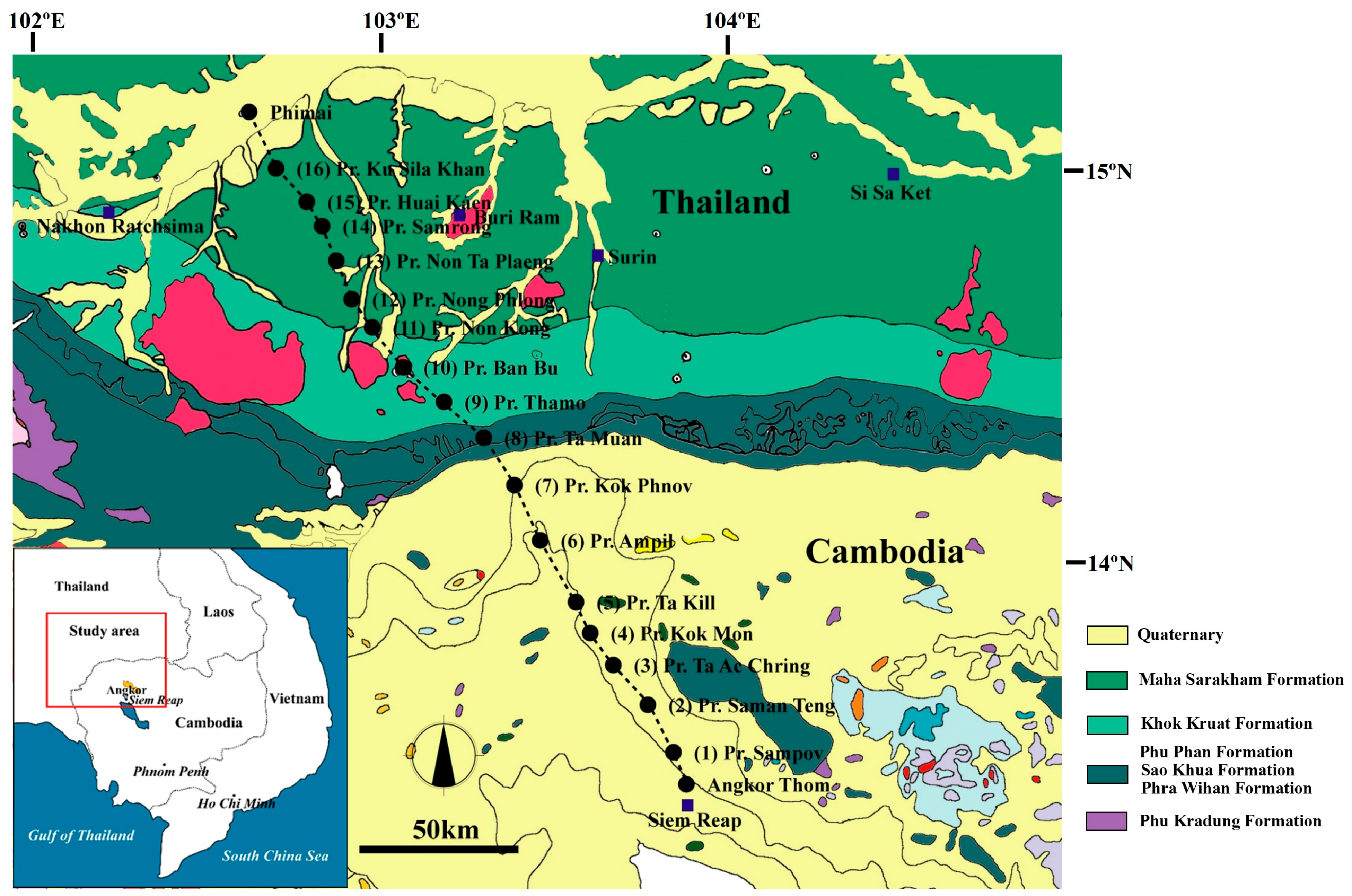
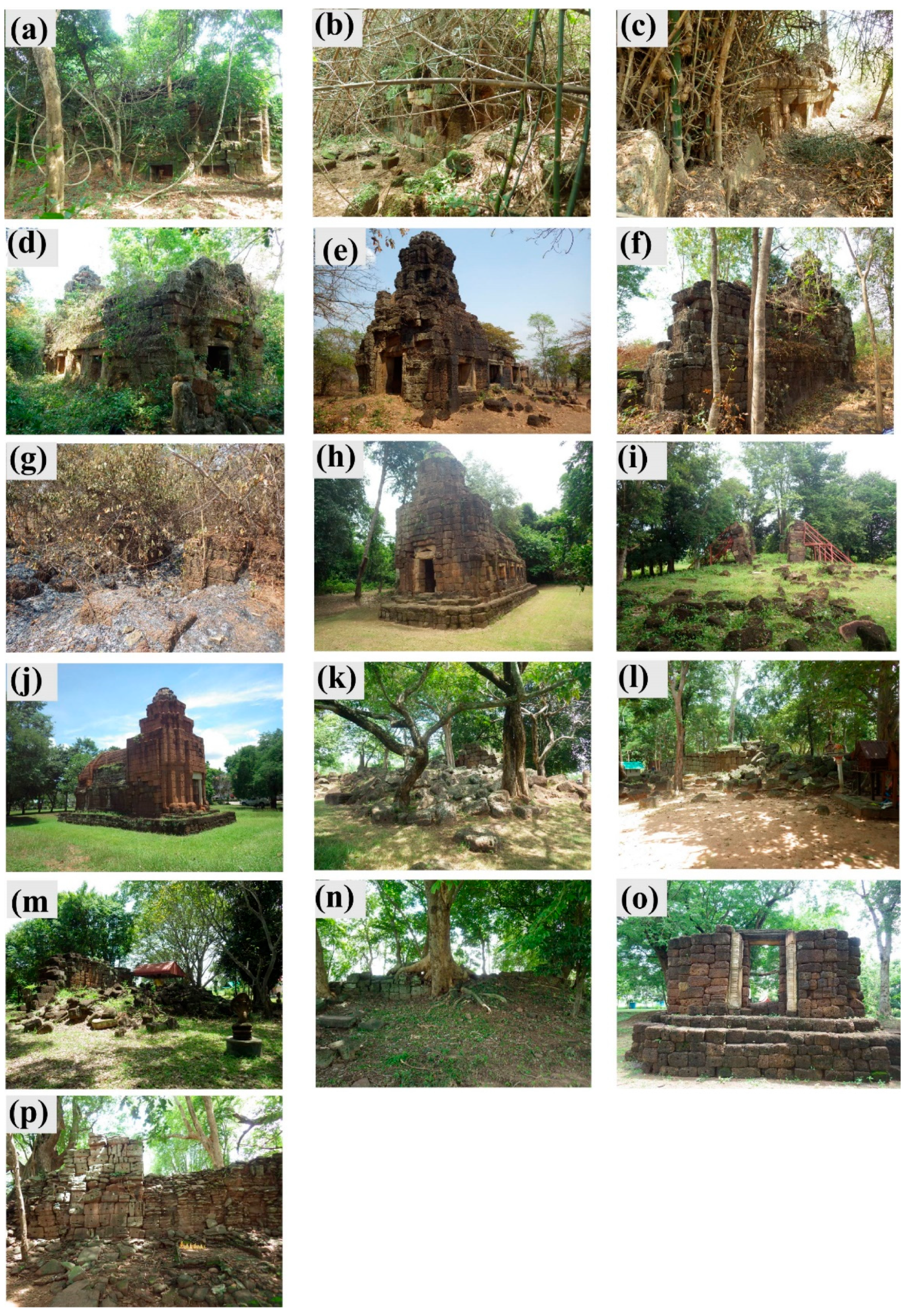
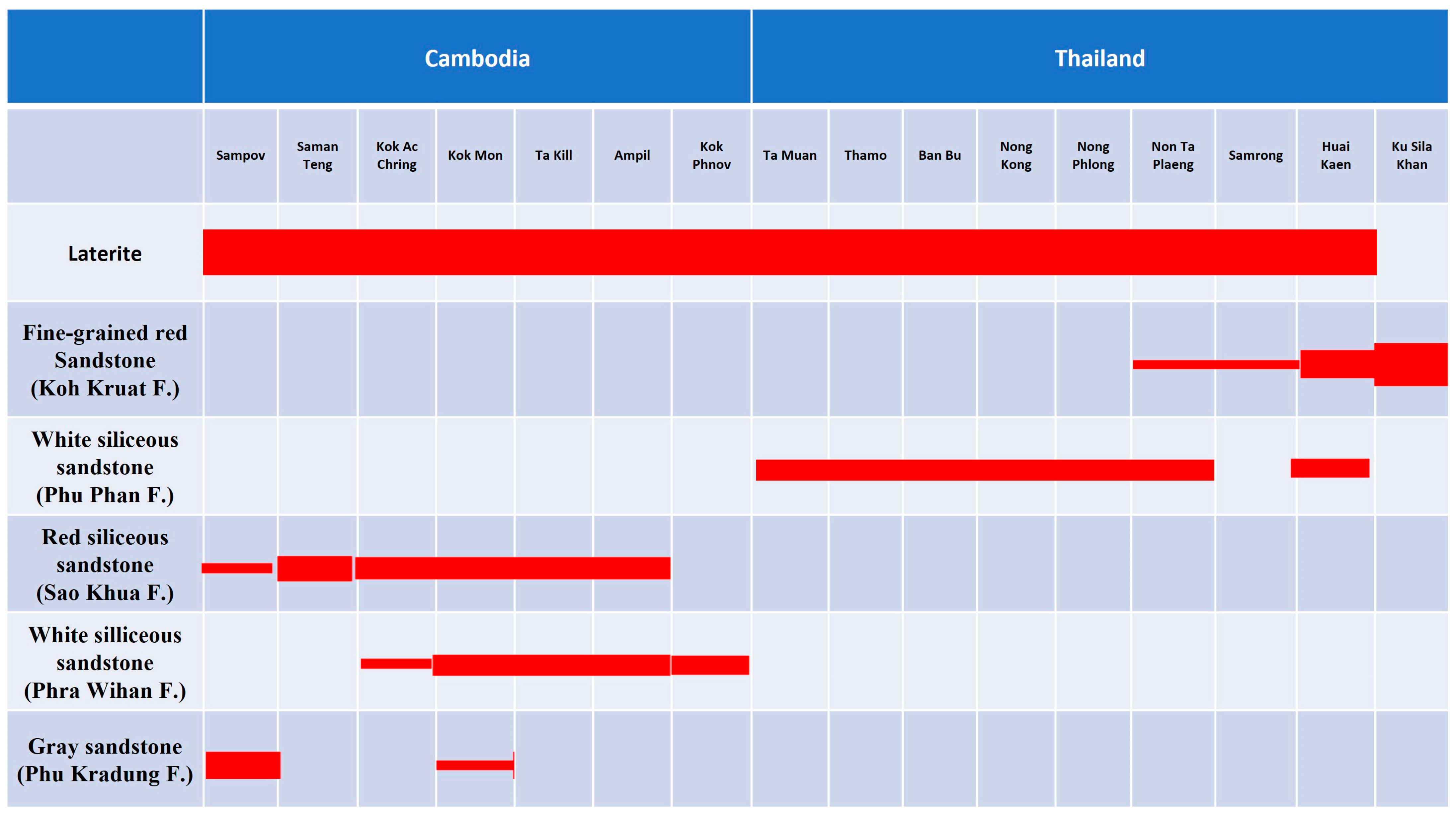

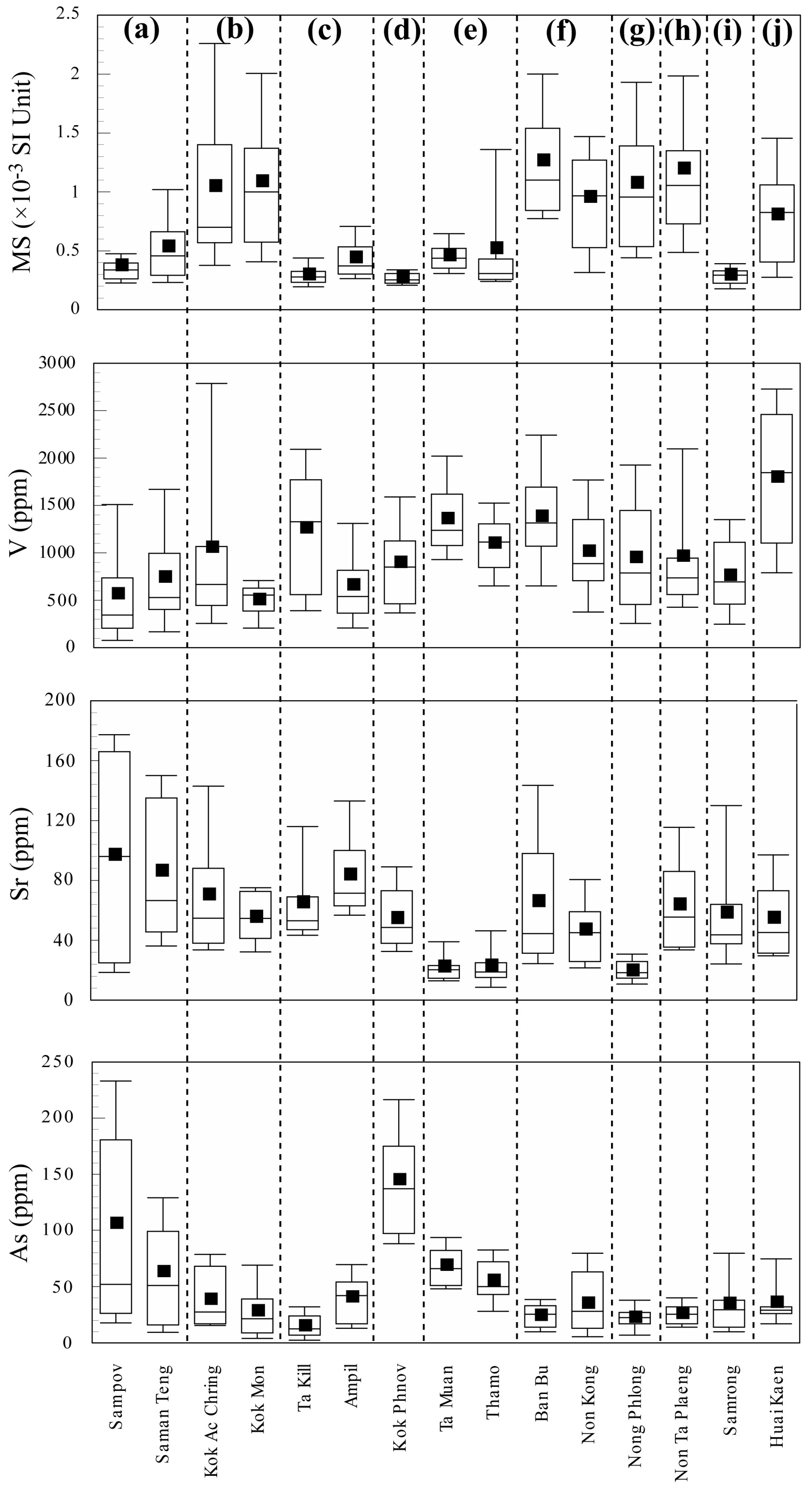
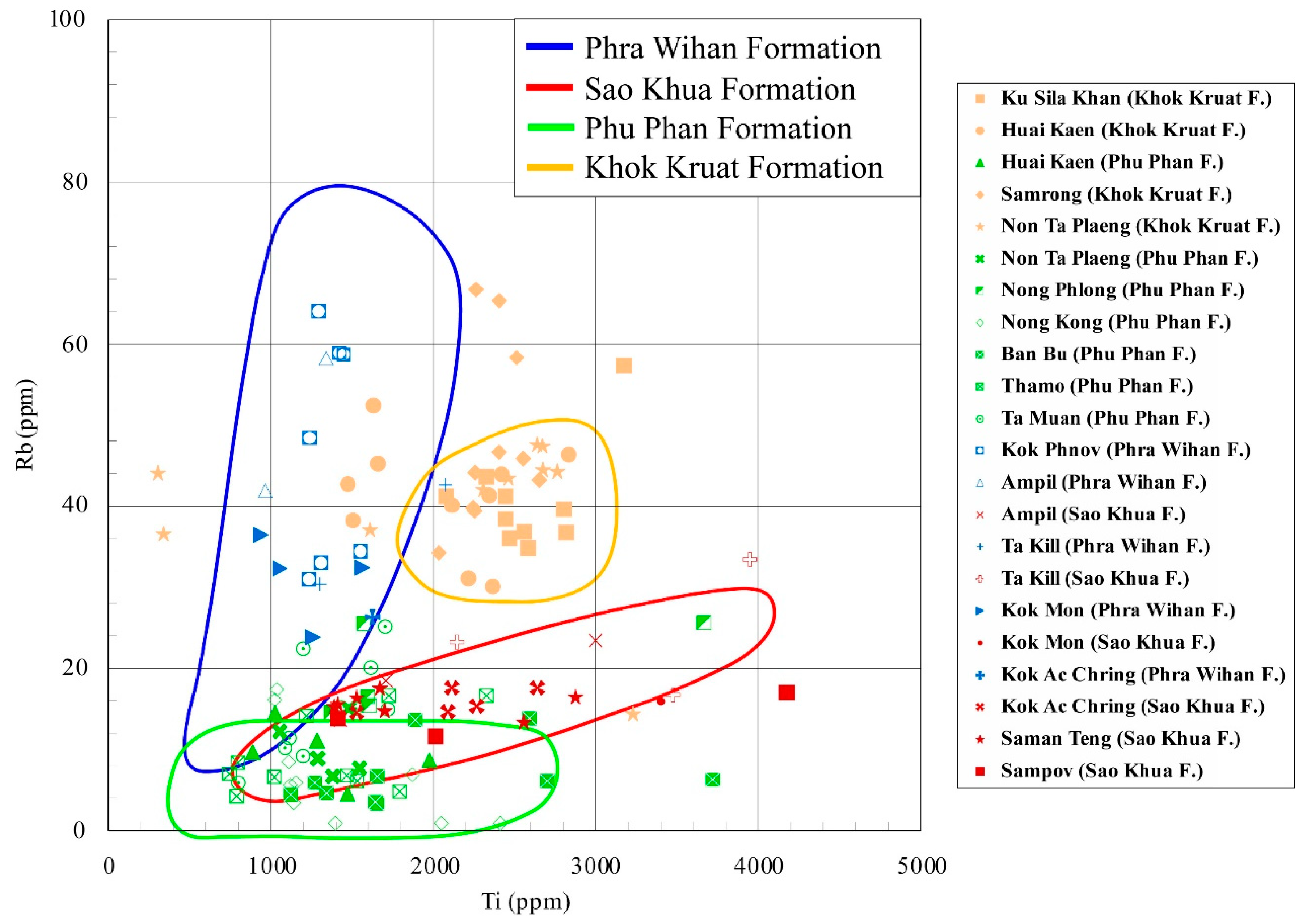
| Resthouse | Latitude | Longitude | Altitude | |
|---|---|---|---|---|
| Thailand | Ku Sila Khan | N 15°04′48.3″ | E 102°36′11.4″ | 233 m |
| Huai Kaen | N 14°58′47.6″ | E 102°42′47.2″ | 175 m | |
| Samrong | N 14°55′59.2″ | E 102°45′14.2″ | 205 m | |
| Non Ta Plaeng | N 14°48′44.7″ | E 102°47′49.9″ | 187 m | |
| Nong Phlong | N 14°43′05.3″ | E 102°50′11.2″ | 186 m | |
| Non Kong | N 14°38′32.8″ | E 102°54′20.0″ | 174 m | |
| Ban Bu | N 14°32′01.5″ | E 102°58′45.4″ | 164 m | |
| Thamo | N 14°27′16.4″ | E 103°07′37.3″ | 177 m | |
| Ta Muan | N 14°21′20.9″ | E 103°15′30.9″ | 194 m | |
| Cambodia | Kok Phnov | N 14°13′46.5″ | E 103°20′32.0″ | 55 m |
| Ampil | N 14°04′44.2″ | E 103°24′57.7″ | 35 m | |
| Ta Kill | N 13°54′30.6″ | E 103°31′49.3″ | 24 m | |
| Kok Mon | N 13°49′57.8″ | E 103°34′38.4″ | 36 m | |
| Kok Ac Chring | N 13°44′39.2″ | E 103°38′47.8″ | 35 m | |
| Saman Teng | N 13°37′45.6″ | E 103°45′26.3″ | 32 m | |
| Sampov | N 13°30′20.6″ | E 103°49′48.8″ | 30 m |
| Laterite | ||||||||||||||||
|---|---|---|---|---|---|---|---|---|---|---|---|---|---|---|---|---|
| Resthouse | Sampov | Saman Teng | Kok Ac Chring | Kok Mon | Ta Kill | Ampil | Kok Phnov | Ta Muan | Thamo | Ban Bu | Non Kong | Nong Phlong | Non Ta Plaeng | Samrong | Huai Kaen | Ku Sila Khan |
| MS * (10−3 SI) | 0.372 | 0.532 | 1.045 | 1.160 | 0.271 | 0.455 | 0.261 | 0.457 | 0.518 | 1.263 | 0.953 | 1.072 | 1.193 | 0.293 | 0.804 | |
| Sr (ppm) | 96.7 | 86.1 | 70.23 | 55.3 | 65 | 129.5 | 54.5 | 22.1 | 22.7 | 65.8 | 46.8 | 19.5 | 63.6 | 58.1 | 49.7 | |
| As (ppm) | 105.7 | 62.9 | 38.3 | 28.1 | 14.8 | 27.7 | 144.7 | 68.5 | 55.1 | 24.1 | 38.8 | 22.4 | 25.8 | 34.7 | 35.7 | |
| V (ppm) | 564 | 740 | 1055 | 503 | 1259 | 2288 | 895 | 1357 | 1098 | 1380 | 1013 | 63 | 961 | 759 | 1795 | |
| Width (cm) | 44.6 | 47.4 | 44.6 | 45.2 | 51.5 | 46.6 | 52.2 | 52.7 | 55.2 | 50.2 | 55.2 | 50.4 | 45.6 | 52.9 | 50.8 | |
| Thickness (cm) | 30.7 | 30.9 | 31.8 | 33.2 | 29.1 | 34.8 | 30.8 | 33.9 | 38.2 | 38.5 | 34.8 | 33.5 | 32.7 | 33.4 | 27.4 | |
| Red siliceous sandstone | Fine-grained red sandstone | |||||||||||||||
| Formation | Sao Khua Formation | Koh Kruat Formation | ||||||||||||||
| Resthouse | Sampov | Saman Teng | Kok Ac Chring | Kok Mon | Ta Kill | Ampil | Kok Phnov | Ta Muan | Thamo | Ban Bu | Non Kong | Nong Phlong | Non Ta Plaeng | Samrong | Huai Kaen | Ku Sila Khan |
| MS * (10−3 SI) | 0.037 ** | 0.024 ** | 0.034 ** | 0.039 ** | 0.040 ** | 0.032 ** | 0.030 ** | 0.102 | 0.105 | 0.083 | 0.109 | |||||
| Rb (ppm) | 14.1 | 15.7 | 15.9 | 15.9 | 24.4 | 18.5 | 40.2 | 48.3 | 41.1 | 40.6 | ||||||
| Sr (ppm) | 32.6 | 31.6 | 46.6 | 52.9 | 50.2 | 51.9 | 71.4 | 62.8 | 82.5 | 59.4 | ||||||
| Ti (ppm) | 2534 | 1876 | 2128 | 3400 | 3191 | 2045 | 2100 | 2358 | 2056 | 2570 | ||||||
| Zr (ppm) | 136 | 147 | 117 | 215 | 165 | 123 | 240 | 226 | 207 | 300 | ||||||
| Width (cm) | 51.1 | |||||||||||||||
| Thickness (cm) | 37.6 | |||||||||||||||
| White siliceous sandstone | ||||||||||||||||
| Formation | Phra Wihan Formation | Phu Phan Formation | ||||||||||||||
| Resthouse | Sampov | Saman Teng | Kok Ac Chring | Kok Mon | Ta Kill | Ampil | Kok Phnov | Ta Muan | Thamo | Ban Bu | Non Kong | Nong Phlong | Non Ta Plaeng | Samrong | Huai Kaen | Ku Sila Khan |
| MS * (10−3 SI) | 0.024 ** | 0.034 ** | 0.039 ** | 0.040 ** | 0.032 ** | 0.030 ** | 0.038 | 0.024 | 0.024 | 0.036 | 0.031 | 0.026 | 0.022 | |||
| Rb (ppm) | 26.3 | 31.2 | 36.5 | 50.1 | 45.6 | 14.9 | 9.1 | 6.8 | 6.7 | 19.5 | 10.1 | 9.7 | ||||
| Sr (ppm) | 20.1 | 36.2 | 27.8 | 55.7 | 31.8 | 15.1 | 19.4 | 34.4 | 18.6 | 16.0 | 24.0 | 22.5 | ||||
| Ti (ppm) | 1627 | 1205 | 1689 | 1152 | 1411 | 1339 | 1342 | 1959 | 1432 | 1962 | 1350 | 1329 | ||||
| Zr (ppm) | 128 | 112 | 116 | 87 | 101 | 90 | 86 | 61 | 69 | 82 | 58 | 81 | ||||
| Gray sandstone | ||||||||||||||||
| Formation | Phu Kradung Formation | |||||||||||||||
| Resthouse | Sampov | Saman Teng | Kok Ac Chring | Kok Mon | Ta Kill | Ampil | Kok Phnov | |||||||||
| MS * (10−3 SI) | 2.960 | 2.160 | ||||||||||||||
| Rb (ppm) | 81.8 | 70.7 | ||||||||||||||
| Sr (ppm) | 197 | 236 | ||||||||||||||
| Ti (ppm) | 3363 | 3558 | ||||||||||||||
| Zr (ppm) | 231 | 212 | ||||||||||||||
Disclaimer/Publisher’s Note: The statements, opinions and data contained in all publications are solely those of the individual author(s) and contributor(s) and not of MDPI and/or the editor(s). MDPI and/or the editor(s) disclaim responsibility for any injury to people or property resulting from any ideas, methods, instructions or products referred to in the content. |
© 2025 by the authors. Licensee MDPI, Basel, Switzerland. This article is an open access article distributed under the terms and conditions of the Creative Commons Attribution (CC BY) license (https://creativecommons.org/licenses/by/4.0/).
Share and Cite
Uchida, E.; Kobayashi, Y.; Mizumori, A.; Kuriyama, K.; Azami, K. Study on Stone Blocks Used for Resthouses Along the Northwest Royal Road Connecting Angkor in Cambodia and Phimai in Thailand Based on On-Site Magnetic Susceptibility Measurements and Chemical Composition Analyses. Heritage 2025, 8, 106. https://doi.org/10.3390/heritage8030106
Uchida E, Kobayashi Y, Mizumori A, Kuriyama K, Azami K. Study on Stone Blocks Used for Resthouses Along the Northwest Royal Road Connecting Angkor in Cambodia and Phimai in Thailand Based on On-Site Magnetic Susceptibility Measurements and Chemical Composition Analyses. Heritage. 2025; 8(3):106. https://doi.org/10.3390/heritage8030106
Chicago/Turabian StyleUchida, Etsuo, Yoshimitsu Kobayashi, Aoi Mizumori, Kaito Kuriyama, and Keishiro Azami. 2025. "Study on Stone Blocks Used for Resthouses Along the Northwest Royal Road Connecting Angkor in Cambodia and Phimai in Thailand Based on On-Site Magnetic Susceptibility Measurements and Chemical Composition Analyses" Heritage 8, no. 3: 106. https://doi.org/10.3390/heritage8030106
APA StyleUchida, E., Kobayashi, Y., Mizumori, A., Kuriyama, K., & Azami, K. (2025). Study on Stone Blocks Used for Resthouses Along the Northwest Royal Road Connecting Angkor in Cambodia and Phimai in Thailand Based on On-Site Magnetic Susceptibility Measurements and Chemical Composition Analyses. Heritage, 8(3), 106. https://doi.org/10.3390/heritage8030106






